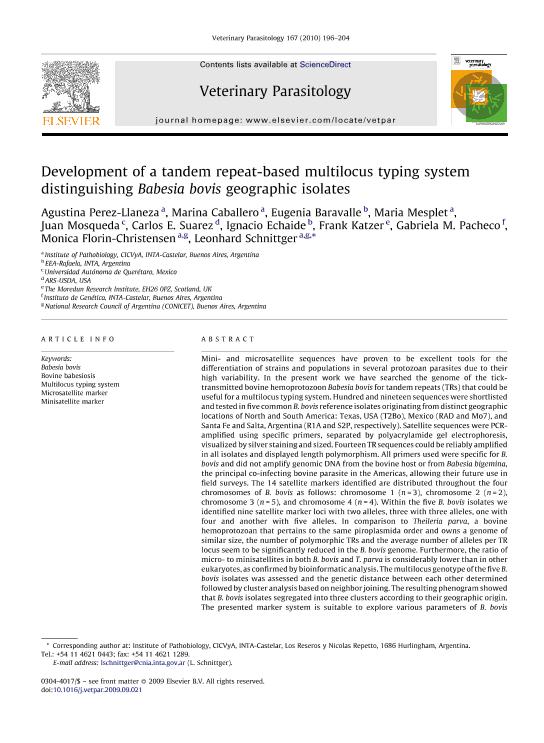Mostrar el registro sencillo del ítem
dc.contributor.author
Perez Llaneza, Agustina
dc.contributor.author
Caballero, Marina

dc.contributor.author
Baravalle, María Eugenia

dc.contributor.author
Mesplet, Maria

dc.contributor.author
Mosqueda, Juan
dc.contributor.author
Suarez, Carlos Esteban

dc.contributor.author
Echaide, Ignacio Eduardo

dc.contributor.author
Katzer, Frank
dc.contributor.author
Pacheco, Maria Gabriela

dc.contributor.author
Florin Christensen, Mónica
dc.contributor.author
Schnittger, Leonhard

dc.date.available
2020-05-05T20:44:17Z
dc.date.issued
2009-09
dc.identifier.citation
Perez Llaneza, Agustina; Caballero, Marina; Baravalle, María Eugenia; Mesplet, Maria; Mosqueda, Juan; et al.; Development of a tandem repeat-based multilocus typing system distinguishing Babesia bovis geographic isolates; Elsevier Science; Veterinary Parasitology; 167; 2-4; 9-2009; 196-204
dc.identifier.issn
0304-4017
dc.identifier.uri
http://hdl.handle.net/11336/104297
dc.description.abstract
Mini- and microsatellite sequences have proven to be excellent tools for the differentiation of strains and populations in several protozoan parasites due to their high variability. In the present work we have searched the genome of the tick-transmitted bovine hemoprotozoon Babesia bovis for tandem repeats (TRs) that could be useful for a multilocus typing system. Hundred and nineteen sequences were shortlisted and tested in five common B. bovis reference isolates originating from distinct geographic locations of North and South America: Texas, USA (T2Bo), Mexico (RAD and Mo7), and Santa Fe and Salta, Argentina (R1A and S2P, respectively). Satellite sequences were PCR-amplified using specific primers, separated by polyacrylamide gel electrophoresis, visualized by silver staining and sized. Fourteen TR sequences could be reliably amplified in all isolates and displayed length polymorphism. All primers used were specific for B. bovis and did not amplify genomic DNA from the bovine host or from Babesia bigemina, the principal co-infecting bovine parasite in the Americas, allowing their future use in field surveys. The 14 satellite markers identified are distributed throughout the four chromosomes of B. bovis as follows: chromosome 1 (n=3), chromosome 2 (n=2), chromosome 3 (n=5), and chromosome 4 (n=4). Within the five B. bovis isolates we identified nine satellite marker loci with two alleles, three with three alleles, one with four and another with five alleles. In comparison to Theileria parva, a bovine hemoprotozoan that pertains to the same piroplasmida order and own a genome of similar size, the number of polymorphic TRs and the average number of alleles per TR locus seem to be significantly reduced in the B. bovis genome. Furthermore, the ratio of micro- to minisatellites in both B. bovis and T. parva is considerably lower than in other eukaryotes, as confirmed by bioinformatic analysis. The multilocus genotype of the five B. bovis isolates was assessed and the genetic distance between each other determined followed by cluster analysis based on neighbor joining. The resulting phenogram showed that B. bovis isolates segregated into three clusters according to their geographic origin. The presented marker system is suitable to explore various parameters of B. bovis populations such as genetic diversity, infection dynamics and their structure under different epidemiological situations, which are of crucial importance for improved control strategies.
dc.format
application/pdf
dc.language.iso
eng
dc.publisher
Elsevier Science

dc.rights
info:eu-repo/semantics/openAccess
dc.rights.uri
https://creativecommons.org/licenses/by-nc-sa/2.5/ar/
dc.subject
BABESIA BOVIS
dc.subject
BOVINE BABESIOSIS
dc.subject
MULTILOCUS TYPING SYSTEM
dc.subject
MICROSATELLITE MARKER
dc.subject
MINISATELLITE MARKER
dc.subject.classification
Ciencias Veterinarias

dc.subject.classification
Ciencias Veterinarias

dc.subject.classification
CIENCIAS AGRÍCOLAS

dc.title
Development of a tandem repeat-based multilocus typing system distinguishing Babesia bovis geographic isolates
dc.type
info:eu-repo/semantics/article
dc.type
info:ar-repo/semantics/artículo
dc.type
info:eu-repo/semantics/publishedVersion
dc.date.updated
2020-04-28T13:07:18Z
dc.journal.volume
167
dc.journal.number
2-4
dc.journal.pagination
196-204
dc.journal.pais
Países Bajos

dc.journal.ciudad
Amsterdam
dc.description.fil
Fil: Perez Llaneza, Agustina. Instituto Nacional de Tecnología Agropecuaria. Centro Nacional de Investigaciones Agropecuarias Castelar. Centro de Investigación en Ciencias Veterinarias y Agronómicas. Instituto de Patobiología; Argentina
dc.description.fil
Fil: Caballero, Marina. Instituto Nacional de Tecnología Agropecuaria. Centro Nacional de Investigaciones Agropecuarias Castelar. Centro de Investigación en Ciencias Veterinarias y Agronómicas. Instituto de Patobiología; Argentina
dc.description.fil
Fil: Baravalle, María Eugenia. Instituto Nacional de Tecnología Agropecuaria. Centro Regional Córdoba. Estación Exptal.reg.agrop.rafaela; Argentina
dc.description.fil
Fil: Mesplet, Maria. Instituto Nacional de Tecnología Agropecuaria. Centro Nacional de Investigaciones Agropecuarias Castelar. Centro de Investigación en Ciencias Veterinarias y Agronómicas. Instituto de Patobiología; Argentina. Consejo Nacional de Investigaciones Científicas y Técnicas; Argentina
dc.description.fil
Fil: Mosqueda, Juan. Universidad Autónoma de Querétaro; México
dc.description.fil
Fil: Suarez, Carlos Esteban. United States Department of Agriculture. Agricultural Research Service; Estados Unidos
dc.description.fil
Fil: Echaide, Ignacio Eduardo. Instituto Nacional de Tecnología Agropecuaria. Centro Regional Córdoba. Estación Exptal.reg.agrop.rafaela; Argentina
dc.description.fil
Fil: Katzer, Frank. The Moredun Research Institute; Reino Unido
dc.description.fil
Fil: Pacheco, Maria Gabriela. Consejo Nacional de Investigaciones Científicas y Técnicas; Argentina. Instituto Nacional de Tecnología Agropecuaria. Centro de Investigación en Ciencias Veterinarias y Agronómicas. Instituto de Genética; Argentina
dc.description.fil
Fil: Florin Christensen, Mónica. Consejo Nacional de Investigaciones Científicas y Técnicas; Argentina. Instituto Nacional de Tecnología Agropecuaria. Centro Nacional de Investigaciones Agropecuarias Castelar. Centro de Investigación en Ciencias Veterinarias y Agronómicas. Instituto de Patobiología; Argentina
dc.description.fil
Fil: Schnittger, Leonhard. Consejo Nacional de Investigaciones Científicas y Técnicas; Argentina. Instituto Nacional de Tecnología Agropecuaria. Centro Nacional de Investigaciones Agropecuarias Castelar. Centro de Investigación en Ciencias Veterinarias y Agronómicas. Instituto de Patobiología; Argentina
dc.journal.title
Veterinary Parasitology

dc.relation.alternativeid
info:eu-repo/semantics/altIdentifier/url/http://www.ncbi.nlm.nih.gov/pubmed/19833439
dc.relation.alternativeid
info:eu-repo/semantics/altIdentifier/doi/http://dx.doi.org/10.1016/j.vetpar.2009.09.021
dc.relation.alternativeid
info:eu-repo/semantics/altIdentifier/url/https://www.sciencedirect.com/science/article/abs/pii/S0304401709005548
Archivos asociados
